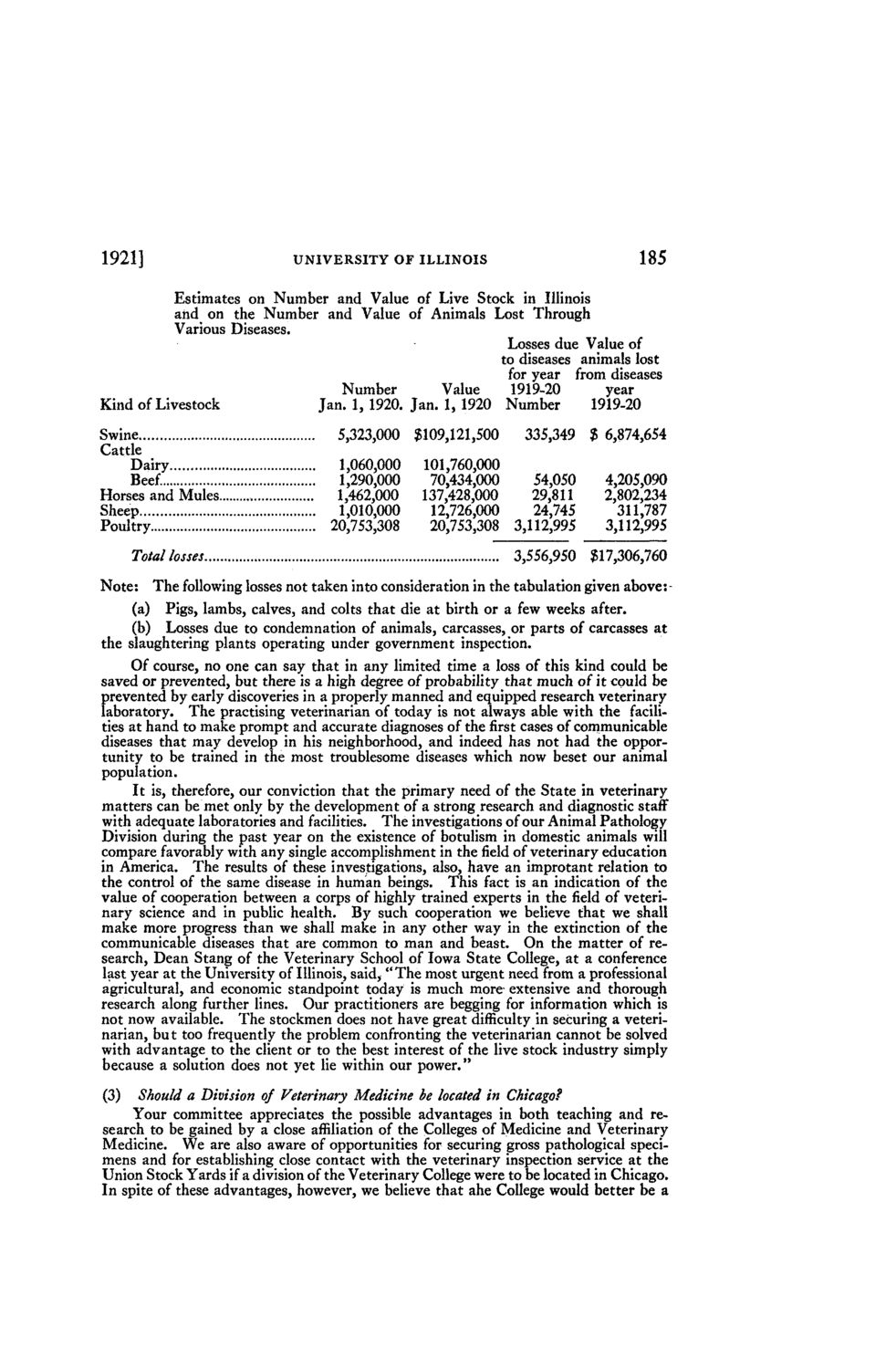| |
| |
Caption: Board of Trustees Minutes - 1922
This is a reduced-resolution page image for fast online browsing.

EXTRACTED TEXT FROM PAGE:
1921] UNIVERSITY OF ILLINOIS 185 Estimates on Number and Value of Live Stock in Illinois and on the Number and Value of Animals Lost Through Various Diseases. Losses due Value of to diseases animals lost for year from diseases Number Value 1919-20 year Kind of Livestock Jan. 1, 1920. Jan. 1, 1920 Number 1919-20 Swine Cattle Dairy Beef. Horses and Mules Sheep Poultry Total losses 5,323,000 1,060,000 1,290,000 1,462,000 1,010,000 20,753,308 $109,121,500 335,349 $ 6,874,654 4,205,090 2,802,234 311,787 3,112,995 $17,306,760 101,760,000 70,434,000 54,050 137,428,000 29,811 12,726,000 24,745 20,753,308 3,112,995 3,556,950 Note: The following losses not taken into consideration in the tabulation given above:(a) Pigs, lambs, calves, and colts that die at birth or a few weeks after. (b) Losses due to condemnation of animals, carcasses, or parts of carcasses at the slaughtering plants operating under government inspection. Of course, no one can say that in any limited time a loss of this kind could be saved or prevented, but there is a high degree of probability that much of it could be prevented by early discoveries in a properly manned and equipped research veterinary laboratory. The practising veterinarian of today is not always able with the facilities at hand to make prompt and accurate diagnoses of the first cases of communicable diseases that may develop in his neighborhood, and indeed has not had the opportunity to be trained in the most troublesome diseases which now beset our animal population. It is, therefore, our conviction that the primary need of the State in veterinary matters can be met only by the development of a strong research and diagnostic staff with adequate laboratories and facilities. The investigations of our Animal Pathology Division during the past year on the existence of botulism in domestic animals will compare favorably with any single accomplishment in the field of veterinary education in America. The results of these investigations, also, have an improtant relation to the control of the same disease in human beings. This fact is an indication of the value of cooperation between a corps of highly trained experts in the field of veterinary science and in public health. By such cooperation we believe that we shall make more progress than we shall make in any other way in the extinction of the communicable diseases that are common to man and beast. On the matter of research, Dean Stang of the Veterinary School of Iowa State College, at a conference last year at the University of Illinois, said, " T h e most urgent need from a professional agricultural, and economic standpoint today is much more extensive and thorough research along further lines. Our practitioners are begging for information which is not now available. The stockmen does not have great difficulty in securing a veterinarian, bu t too frequently the problem confronting the veterinarian cannot be solved with advantage to the client or to the best interest of the live stock industry simply because a solution does not yet lie within our power." Should a Division of Veterinary Medicine be located in Chicago? Your committee appreciates the possible advantages in both teaching and research to be gained by a close affiliation of the Colleges of Medicine and Veterinary Medicine. We are also aware of opportunities for securing gross pathological specimens and for establishing close contact with the veterinary inspection service at the Union Stock Yards if a division of the Veterinary College were to be located in Chicago. In spite of these advantages, however, we believe that ahe College would better be a (3)
| |